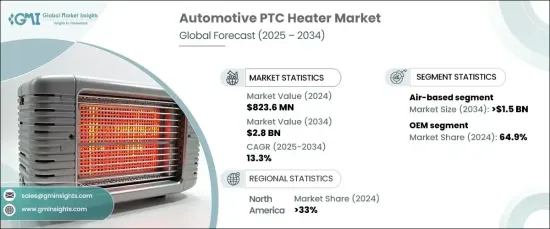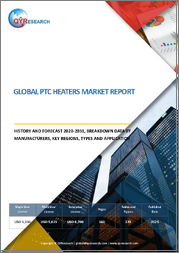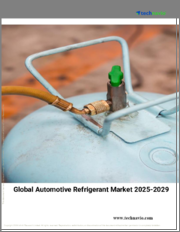
|
시장보고서
상품코드
1665050
세계의 자동차용 PTC 히터 시장 : 기회, 성장 촉진요인, 산업 동향 분석, 예측(2025-2034년)Automotive PTC Heater Market Opportunity, Growth Drivers, Industry Trend Analysis, and Forecast 2025 - 2034 |
||||||
세계의 자동차용 PTC 히터 시장은 2024년 8억 2,360만 달러였고, 2025년부터 2034년까지의 CAGR은 13.3%로 예측되어 현저한 성장이 전망되고 있습니다. 이 성장은 전기자동차의 에너지 효율이 우수한 난방 시스템에 대한 수요의 급증으로 인한 것이 큽니다. 차량 내 난방에 엔진 폐열을 이용하는 내연 엔진 차량과 달리 EV는 PTC 히터와 같은 전기 난방 시스템에 전적으로 의존합니다. 특히 추운 지역에서 EV 채용이 증가하고 있기 때문에 항속 거리를 희생하지 않고 승객의 쾌적성을 높이는 컴팩트하고 에너지 절약적인 솔루션의 필요성이 강조되고 있습니다.

시장 세분화는 제품 유형별로 공기 및 물 기반으로 구성됩니다. 2024년에는 공기식 PTC 히터 시장 점유율이 50%를 차지했고 2034년까지 15억 달러를 창출할 것으로 예측됩니다. 이 시스템은 빠르고 효율적으로 오두막을 데울 수 있기 때문에 매우 선호됩니다. 가볍고 비용 효율적이며 차량 설계에 내장하기 쉬운 공기 히터는 대규모 도입에 적합합니다. 공기식 히터는 물 기반 히터와 달리 복잡한 냉각 메커니즘을 필요로 하지 않으므로 유연한 설치가 가능하며 사용하기 편리합니다. 배터리 소모를 최소화하면서 즉시 따뜻함을 제공할 수 있으므로 최신 EV에 최적의 선택이 되었습니다.
| 시장 범위 | |
|---|---|
| 시작년 | 2024년 |
| 예측연도 | 2025-2034년 |
| 시작금액 | 8억 2,360만 달러 |
| 예측 금액 | 28억 달러 |
| CAGR | 13.3% |
이 시장은 판매 채널별로 분류되어 있으며 OEM 시장과 애프터마켓 시장이 있습니다. 2024년에는 OEM이 64.9%의 점유율을 차지했으며, 이 경향은 예측 기간을 통해 지속될 것으로 예상됩니다. OEM 제조업체는 성능, 내구성 및 비용 효율성을 중시하며 차량 생산 시 PTC 히터를 원활하게 통합합니다. 이 접근법은 신뢰성을 높이고, 엄격한 품질 기준을 준수하며, 애프터마켓에서 조정의 필요성을 최소화합니다. 또한 제조 공정에서의 설치를 간소화하여 업무 효율성과 고객 만족도를 높여 OEM은 시장 성장의 중요한 원동력이 되고 있습니다.
지역별로는 북미가 2024년 자동차용 PTC 히터 시장의 33%를 차지했으며, 그 원동력은 첨단 자동차 부문과 EV 생산의 확대입니다. 이 지역에서는 기술 혁신이 중시되고 자동차 보유율이 높고 규제 프레임워크가 엄격하기 때문에 선진적인 차내 난방 솔루션 수요가 크게 높아지고 있습니다. 또한, 북미의 추운 기후는 효율적이고 신뢰할 수 있는 난방 시스템에 대한 요구를 더욱 높여 시장 성장을 가속하고 있습니다.
자동차용 PTC 히터 시장은 기술의 진보, EV 채용 증가, 소비자의 기호의 진화에 추진되어, 대폭적인 성장을 이루고 있습니다. 업계가 에너지 효율성과 지속가능성을 강조하면서 난방 솔루션의 혁신은 차량 설계의 미래를 형성하고 있습니다. PTC 히터는 편안함, 성능 및 친환경 솔루션에 대한 수요 증가에 대응하며 현대 자동차에 필수적인 부품으로 부상하고 있습니다.
목차
제1장 조사 방법과 조사 범위
- 조사 디자인
- 조사 접근
- 데이터 수집 방법
- 기본 추정과 계산
- 기준연도의 산출
- 시장추계의 주요 동향
- 예측 모델
- 1차 조사와 검증
- 1차 정보
- 데이터 마이닝 소스
- 시장 범위와 정의
제2장 주요 요약
제3장 업계 인사이트
- 생태계 분석
- 공급자의 상황
- 원재료 공급자
- 부품 공급자
- 제조업체
- 기술 제공업체
- 유통업체
- 최종 사용자
- 이익률 분석
- 기술과 혁신의 전망
- 특허 분석
- 규제 상황
- 가격 분석
- 영향요인
- 성장 촉진요인
- EV에 있어서의 차내 난방 수요 증가
- 고급 공조 제어 시스템과의 통합
- 안전성과 내구성에 대한 주목의 향상
- 업계의 잠재적 위험 및 과제
- 높은 초기 비용
- 극한 환경에서의 운전 효율의 한계
- 성장 촉진요인
- 성장 가능성 분석
- Porter's Five Forces 분석
- PESTEL 분석
제4장 경쟁 구도
- 소개
- 기업 점유율 분석
- 경쟁 포지셔닝 매트릭스
- 전략 전망 매트릭스
제5장 시장 추계·예측 : 제품별, 2021-2034년
- 주요 동향
- 공기식
- 물 기반
제6장 시장 추계·예측 : 구조별, 2021-2034년
- 주요 동향
- 핀
- 벌집
제7장 시장 추계·예측 : 판매 채널별, 2021-2034년
- 주요 동향
- OEM
- 공기식
- 물 기반
- 애프터마켓
- 공기식
- 물 기반
제8장 시장 추계·예측 : 차종별, 2021-2034년
- 주요 동향
- IC 엔진
- 배터리 전기자동차(BEV)
- 플러그인 하이브리드 자동차(PHEV)
- 하이브리드 전기자동차(HEV)
제9장 시장 추계·예측 : 용도별, 2021-2034년
- 주요 동향
- HVAC 시스템
- 배터리 열 관리 시스템
- 시트 히터
- 기타
제10장 시장 추계·예측 : 지역별, 2021-2034년
- 주요 동향
- 북미
- 미국
- 캐나다
- 유럽
- 영국
- 독일
- 프랑스
- 이탈리아
- 스페인
- 러시아
- 북유럽
- 아시아태평양
- 중국
- 인도
- 일본
- 호주
- 한국
- 동남아시아
- 라틴아메리카
- 브라질
- 멕시코
- 아르헨티나
- 중동 및 아프리카
- UAE
- 남아프리카
- 사우디아라비아
제11장 기업 프로파일
- Anhui Ankai Electric
- BorgWarner
- Calix AB
- DBK Group
- Dongfeng Motor Parts and Components Group
- Dongguan Sanyou Electrical Appliances
- Eberspächer Group
- Gentherm Incorporated
- Hebei Yingtong Technology
- KLC
- LG Electronics
- Mahle GmbH
- Pelonis Technologies
- Rheinmetall Automotive
- Shanghai Xinye Electronics
- Thermik Geratebau
The Global Automotive PTC Heater Market, valued at USD 823.6 million in 2024, is poised for remarkable growth with a projected CAGR of 13.3% from 2025 to 2034. This growth is largely driven by the surging demand for energy-efficient heating systems in electric vehicles. Unlike internal combustion engine vehicles that utilize waste engine heat for cabin warming, EVs rely entirely on electric heating systems such as PTC heaters. The increasing adoption of EVs, particularly in colder regions, emphasizes the need for compact, energy-saving solutions that enhance passenger comfort without compromising driving range.

Segmented by product type, the market comprises air-based and water-based systems. In 2024, air-based PTC heaters held a commanding 50% market share and are forecasted to generate USD 1.5 billion by 2034. These systems are highly preferred for their ability to provide rapid and efficient cabin heating. Lightweight, cost-effective, and easy to integrate into vehicle designs, air-based heaters are well-suited for large-scale implementation. Unlike their water-based counterparts, air-based systems eliminate the need for complex cooling mechanisms, allowing for flexible installation and ease of use. Their capability to deliver immediate warmth while minimizing battery drain makes them an optimal choice for modern EVs.
| Market Scope | |
|---|---|
| Start Year | 2024 |
| Forecast Year | 2025-2034 |
| Start Value | $823.6 Million |
| Forecast Value | $2.8 Billion |
| CAGR | 13.3% |
The market is also categorized by sales channels, encompassing OEM and aftermarket segments. In 2024, OEMs dominated with a 64.9% share, a trend expected to continue throughout the forecast period. Original equipment manufacturers value performance, durability, and cost-efficiency, integrating PTC heaters seamlessly during vehicle production. This approach enhances reliability, ensures compliance with stringent quality standards, and minimizes the need for aftermarket adjustments. Streamlined installation during manufacturing also improves operational efficiency and customer satisfaction, making OEMs a key driver of market growth.
Regionally, North America represented 33% of the automotive PTC heater market in 2024, driven by its advanced automotive sector and expanding EV production. The region's emphasis on technological innovation, high vehicle ownership rates, and stringent regulatory frameworks significantly fuel demand for advanced cabin heating solutions. Additionally, colder climates in North America further amplify the need for efficient and reliable heating systems, propelling the market growth.
The automotive PTC heater market is on a trajectory of substantial growth, fueled by technological advancements, rising EV adoption, and evolving consumer preferences. As the industry continues to focus on energy efficiency and sustainability, innovations in heating solutions are shaping the future of vehicle design. PTC heaters are emerging as indispensable components in modern vehicles, addressing the increasing demand for comfort, performance, and eco-friendly solutions.
Table of Contents
Chapter 1 Methodology & Scope
- 1.1 Research design
- 1.1.1 Research approach
- 1.1.2 Data collection methods
- 1.2 Base estimates & calculations
- 1.2.1 Base year calculation
- 1.2.2 Key trends for market estimation
- 1.3 Forecast model
- 1.4 Primary research and validation
- 1.4.1 Primary sources
- 1.4.2 Data mining sources
- 1.5 Market scope & definition
Chapter 2 Executive Summary
- 2.1 Industry 3600 synopsis, 2021 - 2034
Chapter 3 Industry Insights
- 3.1 Industry ecosystem analysis
- 3.2 Supplier landscape
- 3.2.1 Raw material suppliers
- 3.2.2 Component suppliers
- 3.2.3 Manufacturers
- 3.2.4 Technology providers
- 3.2.5 Distributors
- 3.2.6 End users
- 3.3 Profit margin analysis
- 3.4 Technology & innovation landscape
- 3.5 Patent analysis
- 3.6 Regulatory landscape
- 3.7 Pricing analysis
- 3.8 Impact forces
- 3.8.1 Growth drivers
- 3.8.1.1 Increasing demand for cabin heating in EVs
- 3.8.1.2 Integration with advanced climate control systems
- 3.8.1.3 Rise in focus on safety and durability
- 3.8.2 Industry pitfalls & challenges
- 3.8.2.1 High initial cost
- 3.8.2.2 Limited operating efficiency in extremely cold environments
- 3.8.1 Growth drivers
- 3.9 Growth potential analysis
- 3.10 Porter’s analysis
- 3.11 PESTEL analysis
Chapter 4 Competitive Landscape, 2024
- 4.1 Introduction
- 4.2 Company market share analysis
- 4.3 Competitive positioning matrix
- 4.4 Strategic outlook matrix
Chapter 5 Market Estimates & Forecast, By Product, 2021 - 2034 ($Bn, Units)
- 5.1 Key trends
- 5.2 Air-based
- 5.3 Water-based
Chapter 6 Market Estimates & Forecast, By Structure, 2021 - 2034 ($Bn, Units)
- 6.1 Key trends
- 6.2 Fin
- 6.3 Honeycomb
Chapter 7 Market Estimates & Forecast, By Sales Channel, 2021 - 2034 ($Bn, Units)
- 7.1 Key trends
- 7.2 OEM
- 7.2.1 Air-based
- 7.2.2 Water-based
- 7.3 Aftermarket
- 7.3.1 Air-based
- 7.3.2 Water-based
Chapter 8 Market Estimates & Forecast, By Vehicle, 2021 - 2034 ($Bn, Units)
- 8.1 Key trends
- 8.2 IC Engines
- 8.3 Battery electric vehicles (BEVs)
- 8.4 Plug-in hybrid electric vehicles (PHEVs)
- 8.5 Hybrid electric vehicles (HEVs)
Chapter 9 Market Estimates & Forecast, By Application, 2021 - 2034 ($Bn, Units)
- 9.1 Key trends
- 9.2 HVAC systems
- 9.3 Battery thermal management systems
- 9.4 Seat heating
- 9.5 Others
Chapter 10 Market Estimates & Forecast, By Region, 2021 - 2034 ($Bn, Units)
- 10.1 Key trends
- 10.2 North America
- 10.2.1 U.S.
- 10.2.2 Canada
- 10.3 Europe
- 10.3.1 UK
- 10.3.2 Germany
- 10.3.3 France
- 10.3.4 Italy
- 10.3.5 Spain
- 10.3.6 Russia
- 10.3.7 Nordics
- 10.4 Asia Pacific
- 10.4.1 China
- 10.4.2 India
- 10.4.3 Japan
- 10.4.4 Australia
- 10.4.5 South Korea
- 10.4.6 Southeast Asia
- 10.5 Latin America
- 10.5.1 Brazil
- 10.5.2 Mexico
- 10.5.3 Argentina
- 10.6 MEA
- 10.6.1 UAE
- 10.6.2 South Africa
- 10.6.3 Saudi Arabia
Chapter 11 Company Profiles
- 11.1 Anhui Ankai Electric
- 11.2 BorgWarner
- 11.3 Calix AB
- 11.4 DBK Group
- 11.5 Dongfeng Motor Parts and Components Group
- 11.6 Dongguan Sanyou Electrical Appliances
- 11.7 Eberspächer Group
- 11.8 Gentherm Incorporated
- 11.9 Hebei Yingtong Technology
- 11.10 KLC
- 11.11 LG Electronics
- 11.12 Mahle GmbH
- 11.13 Pelonis Technologies
- 11.14 Rheinmetall Automotive
- 11.15 Shanghai Xinye Electronics
- 11.16 Thermik Geratebau



















